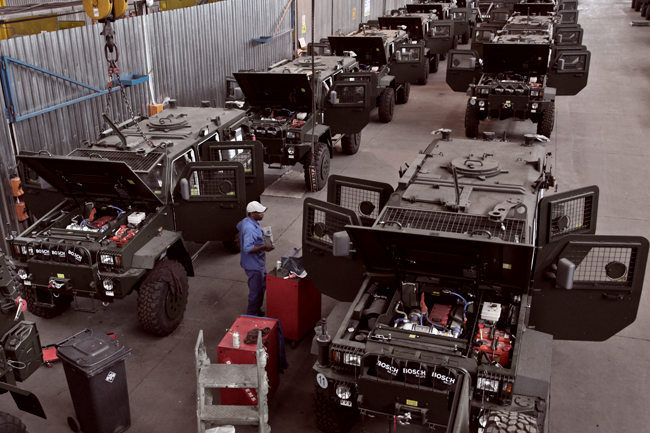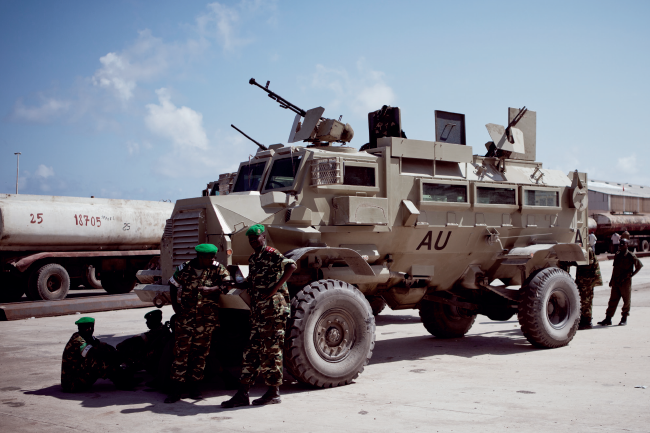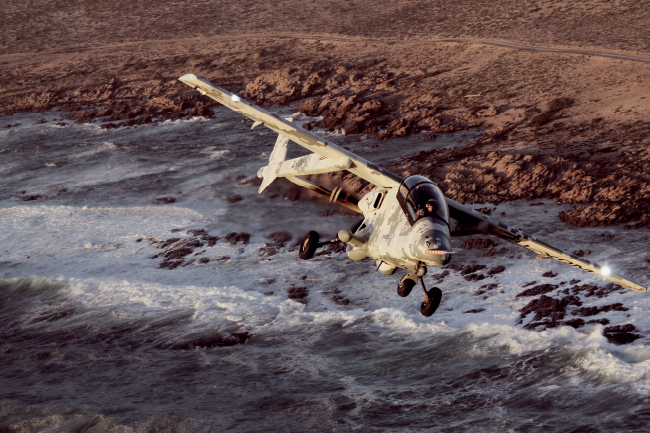Even for an industry that is well versed in tongue-twisting acronyms, ‘AHRLAC’ can be a bit of a mouthful.
To give it its full name, the Advanced High-Performance Reconnaissance Light Aircraft is a South African-designed and developed plane that is expected to enter commercial production this year.
The AHRLAC, a tandem seater with a distinctive pusher propeller behind the crew compartment, will be available in five configurations, including a military version called the Mwari, the name for an omniscient being, taken from African mythology. The producer, Paramount Group, Africa’s biggest privately owned defence manufacturer, has also teamed up with giant US company Boeing to market the Mwari.
‘Negotiations are well under way with a number of countries around the world,’ Paramount Group executive chairman Ivor Ichikowitz told Engineering News.
In February this year, construction work began on a special factory that will be built near Pretoria, South Africa, within the Wonderboom airport precinct. Once completed, the 15 000 m2 complex will turn out two of the aircraft a month, although factory extensions can up that to four if demand develops.
According to Ichikowitz, manufacturing the plane in South Africa is very important to Paramount as one of the company’s primary aims is to help develop skills in the country’s local aerospace industry.
‘The Mwari is something we are very proud of. It is something South Africa can be very proud of. It looks a lot simpler than it is, and this is what makes it special – it is simple. Its technology has been drawn from Paramount Group personnel experience from operations in challenging conditions,’ says Ichikowitz
The AHRLAC was specifically designed to meet the needs of developing countries (negotiating rough ad hoc airfields for example), its service costs are low and it is cheap to run once it’s in the air. The aircraft, which did its first test flight in mid 2014, can be maintained on the ground for short periods by the crew.
‘It can be flown and landed in the bush, parked for a week and then started and flown without any ground support,’ says AHRLAC Holdings CEO Paul Potgieter.
The plane has a large space under the cockpit where a multitude of systems can be quickly interchanged, such as radio wave-detection gear to pick up mobile phone calls (enabling the monitoring of poachers or smugglers) and equipment to film suspicious activity in remote areas. Hardpoints all over the airframe allow for a variety of equipment to be mounted. This means the plane can be reconfigured from, for example, a monitoring and patrolling role to a light attack aircraft with 20 mm cannons and missiles capable of taking on a sudden armed incursion.

‘With a rise in rebel groups using low-cost assets, such as suburban utility vehicles, the Mwari allows for an air force to deploy its own assets on a comparable cost scale to combat a rebel or asymmetric threat. With the Mwari, you are not using a multimillion-dollar jet with expensive missiles to respond to a threat from small rebel groups using civilian vehicles equipped with weapons,’ says Potgieter.
The aircraft is well suited to long surveillance patrols over rugged terrain, watching out for insurgents, poachers as well as pirates and other armed groups. In short, it is highly relevant to the security situations facing many African countries today.
Although the end of the Cold War brought about the decline of the proxy and anti-colonial wars on the continent, there has been an increase recently in the activities of extremist groups in certain areas, for example the Sahel, not to mention piracy off both the West and East African coasts and a spike in organised poaching and smuggling of both weapons and contraband. African armies are also much more involved in peacekeeping missions, such as those in Somalia and the DRC, than they have been in previous eras.
In line with these new threats – and duties – military budgets on the continent increased nearly 9% on average from 2012 to 2013, according to research by the Stockholm International Peace Research Institute. However, mostly due to the 2014 drop in oil prices, military spending in Africa fell by 5.3% in 2015.
Algeria is currently the biggest spender on the continent and the only African country to spend more than US$10 billion a year on the military. Bordering Mali and Libya, Algeria is experiencing civil strife in addition to issues with Al-Qaeda in the Islamic Maghreb (AQIM) in the south of the country. AQIM has made numerous attempts to overthrow the government and instil a hard-line Islamist system. The militant organisation raises money via cigarette smuggling and ransom from kidnappings, and it runs guns throughout the area too.
Other countries are also concerned about the rise of extremism and piracy. The vast distances around coastal regions has necessitated the strengthening of capabilities to protect valuable maritime assets, such as fish stocks from illegal fishing. South Africa currently has a project under way that involves seven new patrol vessels, while Angola, Benin, Ghana and Nigeria have also put resources into these types of small ships.
Yet despite a splurge in spending in recent years, African defence budgets are not on par with the rest of the world. According to the Stockholm International Peace Research Institute’s report on trends in world military expenditure, in 2014 the military expenditure of all African countries combined reached US$50.2 billion, compared to US$62.3 billion by France alone.
Although limited armaments production has taken place in certain African countries – chiefly the manufacture of ammunition – for some time the country with the most sophisticated arms industry has been South Africa. This is partly a legacy of the apartheid era, when the country developed a huge manufacturing base, ranging from artillery, missiles and sophisticated radar and signalling equipment to small naval vessels and aircraft.
One area in which it specialised was the design and manufacture of light armoured vehicles, such as troop carriers. These were not only very rugged to cope with African conditions but also highly successful in protecting troops against land mines.
Now newer generations of these vehicles are being used by many African countries and even further afield – the US has been a major buyer – using them to cope with roadside bombs in Iraq and Afghanistan. The standard models – such as the Casspir and Buffel, which did duty in the former South African Defence Force – have been joined by a multitude of different models made by private contractors such as Paramount as well as the state-owned Denel, which has several divisions covering almost all aspects of defence manufacturing.
Denel not only continues to make the Casspir 35 years after it first took to the bush but also produces the RG-series of armoured vehicles, of which more than 2 200 have been supplied, mostly to Canada and the US.
Other countries using them include Spain and the UAE. Paramount has its Mbombe. Meanwhile, the Gauteng-based DCD Group’s Husky mine-removal system has been in extensive use by the US army and was voted one of their top 10 most innovative advances in army technology. The Husky is a vehicle that uses radar to scan for roadside bombs, while
an accompanying vehicle uses a retractable arm with a camera and claw to uncover them.

Apart from vehicles, Denel has also invested heavily in aeronautics. It was an innovator in Africa with unmanned aerial vehicles (UAVs), more commonly known as drones. Its latest version, the Seeker 400, can be armed with Impi laser-guided missiles and used for a wide range of missions. In March last year, DefenceWeb reported that the South African Air Force was in the process of re-establishing its former UAV unit, 10 Squadron.
In September 2016, Denel unveiled the SARA (South African Regional Aircraft) concept – a full-scale fuselage mock-up of a light civilian plane – at the Africa Aerospace and Defence (AAD) Expo. Held at the Waterkloof air force base in South Africa, the AAD takes place every two years and, in 2016, more than 450 companies from 30 countries participated. In addition to South Africa, several African countries also had a large presence – among them Nigeria, Namibia, Uganda and Sudan.
Denel is eager to introduce SARA to the rest of the continent. The twin-turboprop aircraft is capable of carrying around 24 passengers is and able to operate from rough airstrips away from the standard air routes. SARA has been designed to carry people, freight or a mixture of both.




